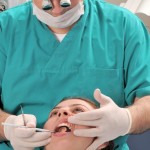
Assessment of the health of the dental pulp is an important step in successful diagnosis. A range of thermal and electric pulp sensitivity test have been used for many years but false-positive and false negative responses are common. Assessment of the blood supply of the dental pulp (pulp vitality) is an earlier indicator which some consider to be the only true indicator of pulp health. Laser doppler flowmetry (LDF) and pulse oximetry (PO) are reportedly able to assess blood flow within the dental pulp directly.
The aim of the review was to critically appraise the literature related to pulp vitality and sensibility testing in order to determine the diagnostic accuracy of pulp tests with reference to a gold standard or control group
Methods
Searches were conducted in the Medline, Embase and Cochrane databases for English language in vivo studies evaluating the accuracy of pulp sensibility and pulp vitality tests in human teeth. Only studies using a reference or ‘gold’ standard and presenting sensitivity and specificity values or data allowing their calculation were considered.
Study selection was undertaken independently by two reviewers with study quality being assessed using the QUADAS (Quality Assessment of Diagnostic Accuracy Studies) tool. A narrative summary of the findings was reported.
Results
- 8 studies (4 Cohorts, 4 Case-controlled) were included
- 5 studies used direct inspection of the dental pulp as a reference standard.
- Partial verification, incorporation and disease progression biases were encountered in 2 studies.
- Information regarding blinding of investigators was missing in 5studies
- The range of sensitivity and specificity values reported for various tests are shown in the table
| No of Studies | Sensitivity
(Range) |
Specificity
(Range) |
|
| Laser Doppler flowmeter | 2 | 100% | 100% |
| Pulse Oximetry | 2 | 81-100% | 95% |
| Electric Pulp Test | 9 | 67-100% | 88-100% |
| CO2 snow | 4 | 89-98% | 76-100% |
| Endo Ice | 4 | 81-100% | 76-100% |
| Ethyl Chloride | 4 | 43-92% | 89-100% |
| Ice Sticks | 2 | 31-47% | 100% |
| Coolant | 1 | 93% | 98% |
| Hand heated Gutta Percha | 1 | 86% | 41% |
Conclusions
The authors concluded
Accurate assessment of the state of health of the dental pulp is challenging. In the context of the critically appraised studies, LDF appeared to be remarkably promising and was the test that came closest to serving as the exclusive gold standard. Assessment of the state of pulpal health using pulp sensibility tests, although subject to error, can provide valuable diagnostic information in the hands of an experienced clinician. Understanding the limitations of such methods, together with using precise application techniques, contributes significantly to the accuracy of the results. The use of LDF is advocated for clinical situations in which pulp sensibility tests are expected to be unreliable, particularly following traumatic dental injuries.
Comments
While reporting sensitivity and specificity data for several methods of dental pulp testing the authors clearly highlight that:-
The number of studies matching the inclusion criteria did not provide a sufficient foundation to evaluate the clinical performance of pulp vitality tests.
They also note that the tests were seldom compared and point to many issues with the conduct of the studies. As clear guidance on the reporting of diagnostic test accuracy studies has been available since 2003 and updated in 2015 ( STARD – Standards for reporting diagnostic accuracy studies) there is a need for this to be better reflected in dental diagnostic test studies. The authors discuss issues related to spectrum bias, ascertainment bias, verification bias and investigator blinding in the included studies. All of these can have an important influence on the study findings. Therefore the summary data for sensitivity and specificity in this review should be interpreted very cautiously.
Links
Primary paper
Alghaithy RA, Qualtrough AJ. Pulp sensibility and vitality tests for diagnosing pulpal health in permanent teeth: a critical review. Int Endod J. 2017 Feb;50(2):135-142. doi: 10.1111/iej.12611. Review. PubMed PMID: 26789282.
Other references
STARD 2015: An Updated List of Essential Items for Reporting Diagnostic Accuracy Studies

[…] Dental pulp testing: insufficient evidence to evaluate clinical performance […]